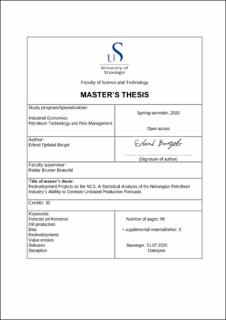| dc.description.abstract | Petroleum companies operating on the Norwegian Continental Shelf (NCS) must receive authority approval of the Plan for Development and Operation (PDO – also called the FID – Final Investment Decision) before a development project can be initiated. In the PDO, the companies present probabilistic forecasts for cost, schedule – and production, which are used to demonstrate the profitability of their projects through the calculation of a value metric, typically the net present value. However, it is well-documented that the Norwegian petroleum industry struggle to complete development projects without budget overruns and schedule delays, and recently Bratvold et al. (2019) established that field developments on the NCS tend to produce significantly less volumes in the early phase than expected at project sanction.
Despite the contribution of Bratvold et.al., the literature on production forecast performance in the oil and gas industry is much less extensive than for cost and schedule. This is due to the fact that operators are neither obliged nor willing to share their production forecasts with the public. As such, this work forms the first public study on probabilistic production forecasting that focus on redevelopment projects, i.e. projects initiated after first oil. The main purpose is to assess the quality of the industry’s production forecasts, which is accomplished by statistically comparing the FID production forecasts for 32 redevelopments with their actual annual production.
The results of the statistical analysis show that the forecasts used in the investment appraisal for redevelopment projects are both optimistic and overconfident. Consistent poor performance relative to the forecasts suggest that the forecasts are biased, which is incompatible with good, economically efficient, decision making. In total, the redevelopments in the study produced 8.3 percent less than the mean forecasted volumes, which translates to a revenue loss of approximately 102 billion 2019-NOK. It is observed that access to historical production data is correlated with forecasts quality, as the redevelopment forecasts improves slightly with years of historical production prior to project approval, while also being less biased than forecasts for new field developments. Flawed human decision making in terms of delusion (honest mistakes) and deception (strategic misrepresentation) is presented as the root cause of the forecasting inaccuracies, and how to improve forecasting by overcoming delusion and deception is also briefly discussed. | en_US |
